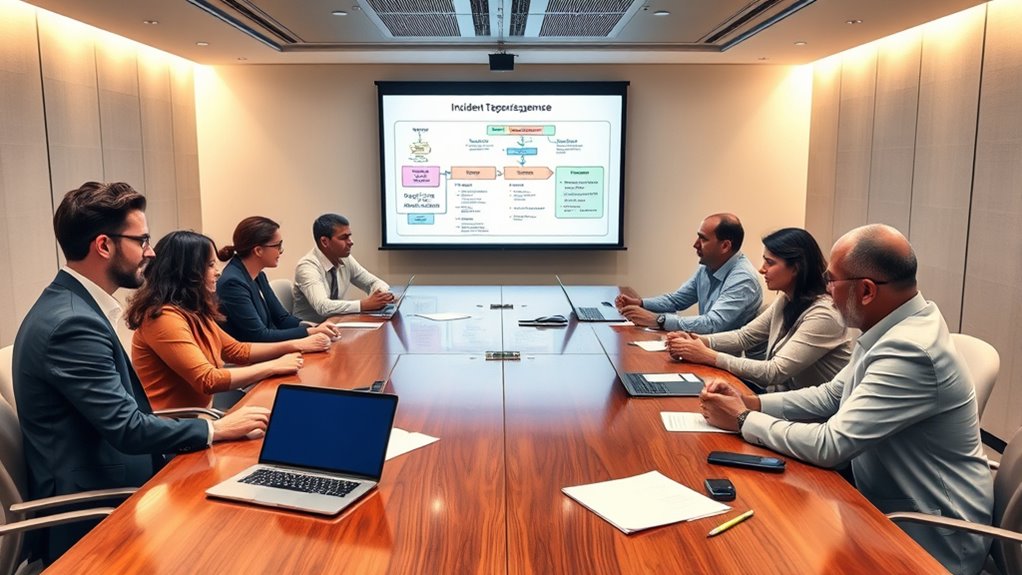To plan an effective incident response tabletop exercise, start by setting clear, measurable objectives focused on key response areas like communication and decision-making. Design realistic scenarios that reflect your organization’s risks and involve relevant participants with clearly assigned roles. Coordinate logistics carefully and run the exercise smoothly. Gather feedback, track performance metrics, and analyze outcomes to improve your plans continually. Continuing this guide will reveal detailed steps to strengthen your cybersecurity readiness.
Key Takeaways
- Define clear, measurable objectives aligned with organizational risks and response gaps before designing realistic scenarios.
- Select diverse participants, assign specific roles, and clarify responsibilities to ensure comprehensive engagement and effective coordination.
- Plan logistics meticulously, including scenario development, venue setup, and resource allocation, for smooth exercise execution.
- Collect feedback and track response metrics like MTTD and MTTR to evaluate performance and identify improvement opportunities.
- Use lessons learned to update incident response plans, foster continuous improvement, and enhance future preparedness.
Establishing Clear Objectives for Your Exercise

Establishing clear objectives is essential for designing an effective incident response table-top exercise. You need to define specific, measurable goals that focus on critical areas like communication, decision-making, and resource management. Tailor these objectives to target known weaknesses or gaps in your current response plans. Use precise language, such as “Assess communication plan effectiveness during a data breach,” to guarantee clarity. Keep objectives focused and achievable within the exercise’s timeframe, enabling you to evaluate performance accurately. Well-defined goals help you measure success against clear indicators, making it easier to identify areas for improvement. Align your objectives with your organization’s risk profile and priorities, ensuring the exercise remains relevant and impactful in strengthening your overall incident response readiness. Clear objectives also facilitate better coordination among team members and external partners, resulting in a more cohesive response effort. Incorporating performance metrics aligned with your goals can further enhance the effectiveness of your evaluations and continuous improvement processes.
Designing Realistic and Relevant Scenarios

Designing realistic and relevant scenarios is essential for effective incident response tabletop exercises because it guarantees your team is prepared for actual threats. To achieve this, embed real employee names, software, and customer data to boost engagement. Reflect current organizational risks and threat profiles, ensuring the scenario mirrors genuine challenges your organization faces. Incorporate industry-specific processes to simulate realistic impacts on operations. Use familiar communication channels and tools to enhance authenticity. Build scenarios as evolving incidents with multiple stages, including unexpected developments and plot twists like new vulnerabilities or secondary attacks. Add constraints such as key personnel unavailability, time pressures, and external influences like media inquiries. Tailor incident types to your specific risks, focusing on those most likely to disrupt your critical assets and services. Additionally, consider including simulated external pressures such as client demands or regulatory inquiries to further increase the realism and stress-testing of your team. Incorporating insights from the Law of Attraction can also help foster a positive mindset and confidence during crisis simulations, enhancing team resilience.
Selecting Participants and Defining Roles

You need to include participants from all relevant departments to make certain your exercise covers every critical aspect of incident response. Clearly defining each role helps prevent confusion and ensures everyone knows their responsibilities. Don’t forget to involve external stakeholders when necessary to simulate real-world coordination and communication. Additionally, involving a diverse group of participants fosters better understanding of the incident response plan’s effectiveness across the organization and encourages collaboration. Inclusive participation ensures that all perspectives are considered during the exercise. Incorporating effective communication strategies can further enhance coordination and response efficiency among team members and external partners.
Diverse Department Inclusion
Selecting participants for incident response tabletop exercises requires careful consideration of their roles, expertise, and departmental relevance. You should include representatives from all key functional areas involved in incident management, such as security officers, facility managers, and incident handling teams like CIRTs. Don’t forget to involve ancillary departments like HR, legal, and communications, since they support incident response indirectly. Balancing technical, managerial, and support roles creates an exhaustive response environment. Make participation mandatory for key personnel based on exercise goals. Assign clear roles—facilitator, evaluator, participant, observer—with explicit expectations. This diversity fosters cross-departmental understanding, encourages knowledge sharing, and reflects real incident challenges, ensuring your exercise is both realistic and effective. Regular inclusion of relevant Glycolic Acid Benefits in skincare routines can also contribute to overall well-being, paralleling the importance of diverse participation in incident planning.
Clarify Responsibilities Clearly
Clearly defining roles and responsibilities before an exercise starts guarantees everyone knows their specific tasks and expectations. You should assign clear incident response roles—such as technical, legal, communications, and leadership—before the exercise begins. Make certain each participant understands their real-world duties within the plan. Also, establish backup personnel for each role to cover absences. Document all role assignments and distribute them to participants ahead of time. Clarify expectations for involvement during detection, response, escalation, and recovery phases. Remember these key points:
- Assign specific roles based on real-world responsibilities.
- Define backup personnel for each role.
- Distribute documented roles before the exercise.
- Clarify each role’s involvement in all incident phases.
Proper role assignment ensures effective coordination and reduces confusion during crisis management. Incorporating role clarity during planning further enhances team preparedness and response efficiency.
Engage External Stakeholders
Engaging external stakeholders in tabletop exercises guarantees diverse expertise and perspectives contribute to a more effective response plan. You should involve risk management partners to facilitate and provide expertise, legal and compliance experts to assess regulatory impacts, and public relations firms to handle external messaging. External auditors can observe and offer valuable feedback, while supply chain partners help evaluate external dependencies. When defining roles, assign a facilitator to guide discussions, observers to provide feedback, legal advisors to assess legal issues, communication specialists to manage messaging, and SMEs for specialized input. Select participants based on organizational needs, including business leaders, IT/security teams, HR, and relevant external partners. Clear communication, relevant scenarios, and a collaborative environment ensure active engagement and maximize the exercise’s value. Additionally, involving external stakeholders also helps ensure compliance with industry standards and regulations, which can be critical during actual incident response efforts. Furthermore, understanding the AI Security landscape enhances the ability to develop comprehensive response strategies.
Planning and Executing the Exercise

Planning and executing a tabletop exercise requires careful coordination to guarantee the session effectively tests your incident response plan. To do this, focus on:
- Defining clear objectives that target specific response areas like communication or resource management.
- Designing realistic scenarios that reflect actual risks your organization faces.
- Coordinating logistics, including venue, timing, and necessary resources, to ensure smooth execution.
- Preparing detailed exercise documents, such as participant roles and scenario details, to guide the session.
- Conducting a post-exercise review to evaluate performance, identify lessons learned, and update your incident response plan accordingly which is essential for maintaining an effective response capability. During execution, a skilled facilitator keeps discussions focused, encourages problem-solving, and simulates decision-making under pressure. This process tests communication pathways, resource allocation, and stakeholder engagement, helping you identify gaps and strengthen your incident response capabilities. Incorporating financial assessment practices can also help ensure resources are allocated appropriately during the exercise.
Gathering Feedback and Measuring Success

To effectively measure your exercise’s success, you need to identify clear effectiveness metrics aligned with your goals. Gathering honest feedback through surveys and debriefs reveals strengths and gaps, guiding continuous improvements. Establishing specific success criteria helps you track progress and demonstrate the value of your incident response efforts. Minimalist design principles can also be incorporated to streamline reporting and focus on what truly matters.
Effectiveness Metrics Identification
Effectiveness metrics are essential for evaluating the success of tabletop exercises and identifying areas for improvement. By establishing clear measures, you can track progress and pinpoint weaknesses. Focus on these key areas:
- Participation Level: Ensure all relevant team members actively engage during exercises to gauge response readiness. Encouraging team coordination can enhance overall effectiveness and foster collaborative problem-solving.
- Scenario Realism: Use realistic scenarios to test response strategies, revealing gaps and weaknesses.
- Feedback Collection: Gather participant insights through surveys or discussions to identify strengths and areas needing enhancement.
- Performance Indicators: Track metrics like mean time to detect (MTTD) and mean time to recovery (MTTR) to assess response efficiency. Measuring system availability can also provide insight into how well incident containment efforts are performing during exercises. Regularly reviewing these indicators helps refine response plans and adapt to emerging threats.
Post-Exercise Improvement Strategies
Gathering feedback and measuring success are critical steps in refining your incident response capabilities after a tabletop exercise. You should use debriefing sessions, anonymous surveys, and real-time documentation to gather detailed insights into response actions, participant experiences, and decision-making. Focus groups and facilitator observations help identify specific challenges and successes, providing deeper understanding. Incorporate input from cross-functional teams, external partners, and leadership to ensure feedback covers all relevant areas. Track improvement opportunities with issue logs, prioritize them by impact, and assign owners to ensure accountability. Set clear deadlines for implementing changes and regularly report progress. Cultivating a culture of continuous learning encourages open dialogue, celebrates successes, and integrates lessons into training, strengthening your response readiness over time. Additionally, understanding Incident Response Fundamentals enables organizations to systematically analyze incidents, ensuring feedback aligns with best practices and enhances overall cybersecurity resilience. Recognizing the importance of feedback loops helps maintain ongoing improvements and adapt strategies effectively.
Success Criteria Establishment
Establishing clear success criteria is essential for accurately evaluating your incident response exercises. It helps you measure progress, identify weaknesses, and guarantee continuous improvement. Focus on both process and outcome metrics, such as:
- Number of gaps identified during exercises
- Improvement in decision-making speed over time
- Increase in participant confidence scores
- Reduction in repeated issues
Additionally, gather feedback through mechanisms like anonymous surveys, interviews, polls, and open forums. These insights reveal participant perspectives and highlight areas for enhancement. You should also assess regulatory compliance by checking adherence to relevant standards and updating policies accordingly. Ultimately, evaluate resource utilization to optimize staffing and tools, ensuring your team responds effectively and efficiently during real incidents.
Analyzing Outcomes and Updating Plans

How do you guarantee that the insights gained from tabletop exercises lead to meaningful improvements in your incident response plan? First, analyze participation and engagement, ensuring scenarios are relevant and roles are clear. Track who participated and their level of involvement, using feedback channels to gather honest insights. Next, evaluate decision-making quality, response times, and how teams handle complex scenarios. Identify gaps in procedures, resources, or vulnerabilities, and document these findings with real-time notes and thorough after-action reports. Conduct debriefings to discuss lessons learned and areas for improvement. Finally, revise your incident response plan based on these insights, updating procedures, reallocating resources, and enhancing training. This iterative process ensures continuous improvement and strengthens your response capabilities. Continuous monitoring and evaluation is essential to adapt strategies as threats evolve and to maintain resilience over time.
Ensuring Continuous Improvement and Future Planning

Ensuring continuous improvement and effective future planning requires engaging stakeholders at all levels and integrating their insights into your incident response process. Involve diverse departments, foster open communication, secure leadership support, and collaborate with external partners. Regular feedback sessions are essential for capturing insights and refining strategies. To optimize your efforts, focus on these key actions: Define clear objectives for each exercise to stay aligned and focused. Use realistic scenarios that mirror actual threats your organization faces. Record and review exercise outcomes to identify improvement areas. Vary formats, locations, and times to challenge teams and uncover new vulnerabilities. Additionally, recognizing that risks evolve constantly, it is crucial to update your plans regularly to stay ahead of emerging threats.
Frequently Asked Questions
How Do I Secure Leadership Commitment for the Exercise?
To secure leadership commitment, clearly communicate how the exercise aligns with their priorities, such as regulatory compliance and risk mitigation. Highlight the benefits of improved decision-making, crisis communication, and organizational resilience. Involve key executives early in planning, making them feel ownership and relevance. Share data on cyber threats and demonstrate how exercises strengthen leadership credibility. Keep them informed on goals and outcomes, emphasizing that ongoing exercises are essential for continuous preparedness and strategic risk management.
What Budget Considerations Are Involved in Planning?
You need to take into account costs for exercise design, facilitation, logistics, and post-exercise review. Budget for scenario creation, expert facilitation, venue or platform fees, travel expenses, and materials. Allocate funds for training, participant preparation, and administrative support. Don’t forget to include resources for after-action reports, follow-up improvements, and periodic re-exercises. Planning for these elements ensures your exercise is thorough, effective, and aligned with your organization’s readiness goals.
How Do I Handle Participant Availability Conflicts?
When handling participant availability conflicts, you should start by pre-scheduling exercises well in advance to find suitable dates. Offer flexible options, including multiple dates and remote participation, to accommodate everyone’s schedules. Communicate early with participants, send reminders, and confirm attendance. If key personnel are unavailable, consider delegates or surrogate roles. Recording sessions or using simulation tools also guarantees everyone stays involved, even if they can’t attend in person.
What Tools Best Support Virtual Tabletop Exercises?
Supporting virtual tabletop exercises is like assembling a puzzle—you need the right tools to fit together seamlessly. Video conferencing platforms like Zoom, Teams, or Webex keep everyone connected in real-time. Shared digital whiteboards such as Miro or MURAL help visualize incident timelines. Instant messaging apps enable quick coordination. Plus, exercise management software facilitates scenario customization and tracking. These tools work together to create an engaging, realistic simulation that tests your team’s response capabilities effectively.
How Often Should Exercises Be Repeated for Effectiveness?
You should repeat tabletop exercises based on your organization’s risk level and industry requirements. For high-risk sectors, quarterly sessions are recommended to stay prepared. Even if annual exercises are common, increasing frequency during major IT changes or regulatory updates helps maintain sharp skills. Regular practice builds confidence, improves coordination, and keeps response strategies current. Vary scenarios and include all stakeholders to maximize learning, ensuring your team remains ready for evolving threats.
Conclusion
By following these steps, you’ll strengthen your incident response readiness. Did you know that organizations that regularly conduct tabletop exercises are 40% more effective at handling real crises? This statistic highlights the importance of continuous practice. Keep refining your scenarios, engaging participants, and learning from each exercise. With dedication, you’ll build a resilient plan that can confidently face any incident, safeguarding your organization and its future.









